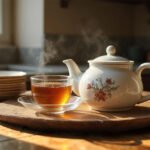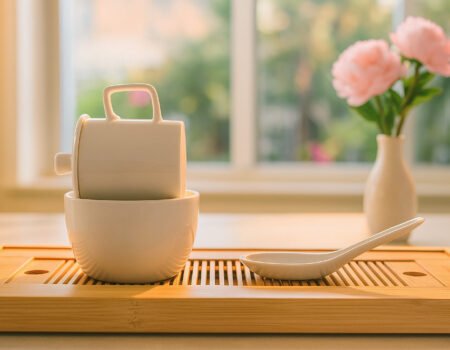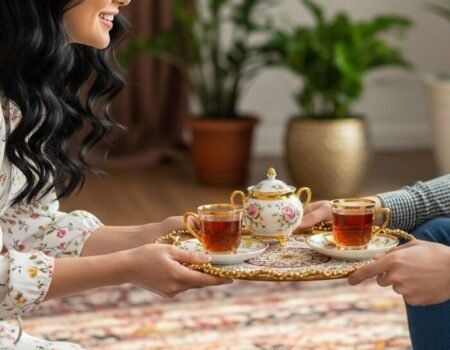
Essential Tips for Teaware Care: Teapot Maintenance, Matcha Rituals & More!
Index
Index
Neglected teaware can ruin your tea experience with bad tastes and stains that won’t budge. Studies show that most teapot damage happens right at home due to poor maintenance habits.
Proper teaware care extends the life of your favorite pieces and enhances the flavor of every cup you brew. This guide covers everything from daily cleaning routines to special techniques for porcelain, Yixing clay, and matcha tools.
Your tea rituals deserve the best treatment.
Key Takeaways
- Daily cleaning with warm water removes tea residue and prevents stains from setting in your teaware.
- Avoid using soap on unglazed clay teapots like Yixing, as the porous material absorbs soap flavors.
- Dry teaware completely after each use to prevent mold growth, with teapots positioned upside down or with lids ajar.
- Yixing clay teapots should be dedicated to one tea type only and seasoned properly to develop their unique patina.
- Different materials need specific care: glass shows stains quickly, cast iron requires rust prevention, and bamboo tools must be stored properly to maintain their shape.
Fundamental Teaware Care Practices

Proper teaware care starts with simple daily habits that extend the life of your favorite pieces. You need basic supplies like soft cloths and mild cleaning agents to keep your tea vessels in top shape.
Daily Cleaning and Drying Essentials
Proper teaware care starts with daily cleaning habits. These simple steps will keep your tea vessels in prime condition and preserve the pure flavors of your next tea session.
Essential Cleaning Practices
Basic Maintenance Routine
- Rinse your teaware right after use with plain warm water to remove tea residue and prevent stains from setting in
- Clean glazed porcelain and glass teaware with a soft cloth and lukewarm water for regular maintenance
- Wipe tea tables with a damp cloth after tea sessions to remove spills that might damage the wood over time

Material-Specific Care
Protecting Different Teaware Types
- Avoid using soap on unglazed teapots like Yixing or Tokoname kyusu, as the porous clay absorbs soap flavors that will taint future brews
- Keep silver teaware free from tarnish with regular quick rinses and thorough drying after each use
- Store chasen (matcha whisks) upright in a kusenaoshi (whisk holder) after rinsing to maintain their shape and prevent mildew
Detailed Cleaning Techniques
Addressing Stubborn Issues
- Tackle tough stains on glazed teaware with a gentle mixture of baking soda and water, which lifts discoloration without scratching surfaces
- Pay special attention to spouts and strainers where tea leaves often get stuck, using a small brush to clear blockages
Proper Drying and Storage
Preventing Damage Through Correct Storage
- Dry your teaware completely after each cleaning to prevent mold growth and extend its lifespan
- Position teapots upside down or with lids slightly ajar to ensure air circulation during drying

Proper handling during cleaning matters just as much as the cleaning itself. Let’s explore how to prevent damage through smart storage and handling practices.
Preventing Damage Through Proper Handling and Storage
Beyond daily cleaning, smart handling keeps your teaware safe from damage. Store your teapots, cups, and bowls in a dry cabinet away from direct sunlight to prevent color fading and material stress.
Pick up ceramic pieces with both hands rather than by handles or spouts, which can snap off under pressure. For stacking, place soft cloth between items to avoid scratches or chips on delicate porcelain surfaces.
Storage location matters greatly for different tea tools. Bamboo items like chashaku need cool, dry spots to stop warping. Yixing teapots should breathe, so avoid airtight containers that trap moisture.
Cast iron kettles must stay completely dry to prevent rust formation. Glass teaware benefits from padded storage to guard against cracks. These simple habits extend the life of your tea collection and maintain the quality of each brew you make.
Caring for Ceramic Teaware Varieties

Ceramic teaware demands specific care based on its type and finish. Different clay bodies and glazes need unique cleaning methods to preserve both beauty and function.
General Maintenance for Porcelain and Glazed Ceramics
Porcelain teaware requires gentle handling to maintain its beauty and function. Hand-painted porcelain teapots need hot water rinses rather than dishwasher cleaning to protect their delicate glazes from damage.
After each use, rinse your ceramic teapot with hot water and avoid dish soap which can leave residue that affects tea flavor. A soft cloth works well for drying and removing tea stains without scratching the surface.
Stubborn stains on glazed ceramics often respond to natural cleaners like baking soda or a mixture of vinegar and water. These mild solutions clean effectively without harsh chemicals that might harm the glaze or affect future brews.
Many tea experts suggest rinsing porcelain teaware with hot water before first use to remove any manufacturing dust or residue. This simple step helps ensure your first cup tastes pure and clean.
Specialized Needs of Unglazed Yixing Clay

Unglazed Yixing clay teapots need special care due to their porous nature. These unique vessels absorb tea flavors over time, creating a rich patina that enhances future brews. You must avoid soap or detergent with these pots as they can seep into the clay and taint your tea.
Instead, rinse your Yixing pot with boiling water after each use. For deeper cleaning, place the teapot in room temperature filtered water for two days, making sure both pot and lid stay fully submerged.
Proper drying prevents mold growth in these porous teapots. After rinsing, dry the outside with a soft cloth and leave the lid off to let air circulate inside. The seasoning process builds flavor in your Yixing pot.
On the third day of the cleaning cycle, put your teapot in a pot of water and bring it to a boil. This helps remove any lingering odors while preparing the clay to absorb the character of your favorite tea.
Many tea enthusiasts dedicate specific Yixing pots to particular tea types to maintain pure flavor profiles.
Seasoning and Long-Term Care for Yixing Pots
Yixing clay teapots need proper seasoning to enhance their brewing qualities. These special pots improve with age and regular use, developing a rich patina that benefits your tea.
Initial Setup and Dedication
Preparing Your Yixing Pot
- Season new Yixing pots before first use by rinsing with hot water and brewing tea leaves inside for 10-15 minutes
- Dedicate each pot to one type of tea only, as the porous clay absorbs tea oils and flavors over time
- Match your pot to the right tea type, as different Yixing clays complement specific varieties
Daily Care Routine

Essential Maintenance Practices
- Clean your pot with plain water after each use, avoiding soap which can seep into the clay and affect tea taste
- Dry the pot completely with the lid off to prevent mold growth and musty smells
- Use your pot often for optimal results, as regular brewing helps develop its character and shine
Building Your Pot’s Patina
Developing Character Over Time
- Apply a small amount of tea to the outside surface with a soft cloth to build an even patina over time
- Polish your pot occasionally with dry tea leaves to maintain its natural luster
- Test your pot’s seasoning progress by comparing tea brewed in it versus a neutral vessel
Storage and Protection
Preserving Your Investment
- Store your teapot in a well-ventilated area away from strong odors that the clay might absorb
- Wipe the exterior with a damp cloth if dust accumulates, then dry it fully before storage
- Keep the pot away from direct sunlight which can fade its color over time
- Avoid sudden temperature changes that might crack the clay body of your teapot
Troubleshooting Common Issues
Addressing Specific Problems
- Fix mineral deposits by gently scrubbing with a soft toothbrush and warm water
- Inspect the lid fit regularly, as thermal expansion may affect how well it seals.
Material-Specific Guidance for Non-Ceramic Teaware

Different materials need different care methods beyond ceramic teaware. Glass, cast iron, silver, and bamboo each have unique needs that affect the taste of your tea.
Maintaining Glass Teaware Clarity
Glass teaware shows tea stains quickly, so prompt cleaning is essential. We rinse our glass teapots and cups right after use to stop residue from setting. Baking soda or toothpaste works magic on stubborn tea marks that regular washing misses.
For those annoying water spots that dull your glass, a soak in warm water with lemon juice brings back the shine.
Vinegar proves valuable for glass teaware that holds lingering flavors from previous brews. A quick vinegar rinse strips away old tea tastes without harming the glass surface. This step matters most for delicate Japanese tea vessels used in tea ceremonies, where purity of flavor impacts the whole experience.
Glass teaware needs gentle handling too—avoid harsh scrubbing that might scratch the surface and create spots for stains to grip.
Cast Iron Teaware: Cleaning and Rust Management

Cast iron teapots demand special care to maintain their beauty and function. These traditional vessels offer unique brewing benefits but need proper maintenance to prevent rust and damage.
Initial Seasoning Process
Preparing New Cast Iron Teaware
- Season new tetsubin before first use by rinsing with warm water and boiling water in them several times to create a protective layer
- Brew tea regularly in your cast iron pot to maintain its seasoning and prevent rust through consistent use
Daily Cleaning Routine
Proper Maintenance Methods
- Avoid using soap or detergents on cast iron teaware as they strip away the seasoning and natural oils that protect against rust
- Clean your cast iron pot after each use with plain warm water and a soft cloth to remove tea residue without damaging the surface
- Rinse thoroughly after any rust treatment to remove all cleaning agents before drying the teapot completely
Essential Drying Techniques

Preventing Moisture Damage
- Dry both the inside and outside of your teapot completely after washing to prevent moisture from causing rust formation
- Heat dry your teapot on low heat in the oven or on a warm stove (if manufacturer approved) to ensure no moisture remains in porous areas
- Store tetsubin in a dry, well-ventilated area away from humidity to maintain its condition between uses
Rust Prevention and Treatment
Maintaining Your Investment
- Apply a thin layer of vegetable oil occasionally to the exterior of unglazed areas to maintain the patina and prevent oxidation
- Remove existing rust spots with a soft brush and a paste made from baking soda and water, gently scrubbing the affected areas
- Test water quality if you notice frequent rust issues, as hard water can accelerate oxidation in cast iron teaware
Important Safety Considerations
Protecting Your Teaware
- Never place your enameled cast iron teapot directly on a stove or heat source as this can damage the protective enamel coating, these vessles are only for brewing tea not only boiling water.
Silver Teaware: Addressing Tarnish and Upkeep

Silver teapots bring elegance to tea time but need special care to stay beautiful. These delicate vessels require regular attention to prevent tarnishing and maintain their shine.
Understanding Silver Teaware
Why Silver Requires Special Care
- Silver teaware tarnishes from air exposure, creating a dull film that affects both looks and taste
- Handle silver teapots with clean hands since skin oils speed up the tarnishing process
Daily Cleaning Routine
Essential After-Use Care
- Clean your silver teapot after each use with warm water and dry it fully with a soft cloth
- Dry your silver teapot completely before storage to prevent water spots and corrosion
- Avoid harsh cleaners or abrasive sponges that scratch silver’s surface and damage its finish
Tarnish Removal Methods

Natural Cleaning Solutions
- Make a paste with baking soda and water to remove light tarnish from silver surfaces
- Deep-set stains respond well to a paste made from bicarbonate of soda applied gently
- Lemon juice mixed with salt creates an effective natural cleaner for light tarnish removal
Deep Cleaning Techniques
Periodic Maintenance
- Boiling water mixed with yeast powder breaks down stubborn tea residue inside silver teapots
- Tea oils can build up over time, so deep clean your silver teaware every few months
- Polish your silver teapot monthly with a quality silver polish to maintain its luster
Proper Storage Solutions
Protecting Your Investment
- Store silver teaware in tarnish-resistant cloth bags or lined boxes away from moisture
- Line storage areas with acid-free tissue paper to protect silver from environmental damage
- Apply a thin coat of mineral oil to prevent tarnish if storing silver teaware for extended periods
Regular Maintenance Checks
Ensuring Longevity
- Check for loose handles or damaged parts regularly as silver can weaken with use
Care for Bamboo Teaware Accessories

Bamboo tools like the chasen (matcha whisk) and chashaku (matcha scoop) need special attention to last longer. Your chasen requires soaking in hot water before its first use to prepare the tines for whisking.
Keep it slightly damp before each use but avoid long soaks or dishwasher cleaning which can damage the delicate bamboo. Proper storage matters too – always place your chasen upright on a Kusenaoshi (whisk holder) to maintain its shape and prevent the ends from closing together.
The chashaku demands different care from its whisk counterpart. This bamboo scoop must stay dry at all times to prevent warping or mold growth. If matcha powder sticks to your chashaku during use, simply wipe it with a clean, dry cloth rather than washing it with water.
These simple practices will extend the life of your bamboo tea tools significantly. Silver teaware presents its own unique challenges that require specific cleaning methods to maintain its luster.
Conclusion

Proper teaware care extends the life of your treasured pieces and enhances your daily tea ritual. Regular cleaning with mild soap, thorough drying, and correct storage prevent damage while preserving the unique qualities of each item.
Your Yixing clay pot needs special attention through proper seasoning, while glass, cast iron, and silver pieces each require specific maintenance approaches. Caring for your teaware shows respect for the craft and traditions behind these beautiful objects.
Taking these simple steps will reward you with many years of perfect brews and the quiet joy that comes from using well-maintained tea tools.
FAQs
1. How should I clean my teapots and unglazed teaware?
Never use soap or mild detergent on unglazed teaware as it absorbs flavors. Instead, rinse with hot water after each use. For stubborn stains, try a paste of baking soda (sodium bicarbonate) and water, then rinse well and let it air dry completely.
2. What’s the proper way to care for a matcha tea bowl (chawan)?
Rinse your chawan with warm water after each use. Avoid harsh soaps that might affect the ceramic glaze and future brews of tea. Gently wipe with a damp cloth if needed, then allow it to air dry completely before storing.
3. Can I use vinegar or lemon juice to clean my teaware?
Yes, vinegar or lemon juice works well for removing mineral deposits from pottery and ceramic teaware. Apply with a wet cloth, rinse thoroughly, and dry completely.
4. How should I store my teaware when not in use?
Store teaware in a dry place away from direct sunlight for extended periods of time. Make sure pieces are completely dry before storing to prevent mold growth. For special items like Hagi ware or Raku ware with natural porosity, proper storage prevents unwanted craquelure.
5. Is dishwashing safe for all types of teaware?
No. Hand washing is best for most teaware. Dishwashing machines can damage delicate pieces used for tea ceremonies, gongfu tea, or Japanese tea ceremony traditions. The harsh cycle might harm the glaze and affect how your tealeaves infuse.
6. How do I maintain a tea pet?
Tea pets need regular attention with leftover tea. Pour cooled tea over your tea pet during each tea session. This ritual, popular in Asian tea culture, helps develop a beautiful patina over time. Just rinse occasionally with water and never use soaps.
References
- https://www.tezumi.com/blogs/tezumi-insights/taking-care-of-your-teaware?srsltid=AfmBOooqa13KCeUnEcYwrPbTDMEOxUNNG2eYYI-mGTIeuVAuicpQ8Qqc
- https://www.tezumi.com/blogs/tezumi-insights/taking-care-of-your-teaware?srsltid=AfmBOopYH-fGbbVRlwOl_rwOPLYMXDtvfqyYxPR1-hCCULRXzGDIJd-O
- https://www.tezumi.com/blogs/tezumi-insights/taking-care-of-your-teaware?srsltid=AfmBOoqD16Zc5VtDzEtDxDArBamnz75JpCsnu5nrvx9Ztd8LvRtOkz-I
- https://www.sazentea.com/m/blog/lexicon/how-to-take-care-of-your-teaware.html?srsltid=AfmBOopR7ySK7FleLIBrKzRhSgjtOlqScNBemQfPELIWTHqUS83aqFW7
- https://www.teaforum.org/viewtopic.php?t=612
- https://pathofcha.com/blogs/all-about-tea/taking-care-of-your-yixing-teapot-5-easy-steps?srsltid=AfmBOoqbpvqlBRNIFOxJ-pxJL-aTcN11Tdb4-c4Gnv70qDUH_e9J7FA9
- https://pathofcha.com/blogs/all-about-tea/taking-care-of-your-yixing-teapot-5-easy-steps?srsltid=AfmBOoqxJ0eSaFzD3CUKtEpsXP0x50Hs8IanSXoAvcdFilY96gTCRDE3 (2020-09-21)
- https://tea101.teabox.com/how-to-maintain-your-teaware
- https://luluteaware.com/how-to-use-and-clean-a-cast-iron-teapot/?srsltid=AfmBOorRJqe7Jc5dRMVu0ShLdfuO5nKnYQH3k94XjMaG2knF-5trOQmL
- https://www.republicoftea.com/blog/tea-library/cast-iron-teapot-care-instructions/tl-011/?srsltid=AfmBOopGGnNqKUcbLDmFyZ_-YJBMQjdVK08WdwrZXeQOJyAQWZGTv2W0
- https://www.marrakeche.com/how-to-clean-teapot/?srsltid=AfmBOoq19aGV0fD8nGesyyaD9NpItwpA4SqEKWy3SqyKppoKlbM9RpWh
- https://tching.com/2022/08/cleaning-teaware-bathing-immortals/
- https://musubikiln.com/blogs/journal/how-to-care-for-your-chasen?srsltid=AfmBOorVZEz9DsYQNcnbxmmqABmlo7weyAVWQJcrAxBdWtL3Zz3vb54s






